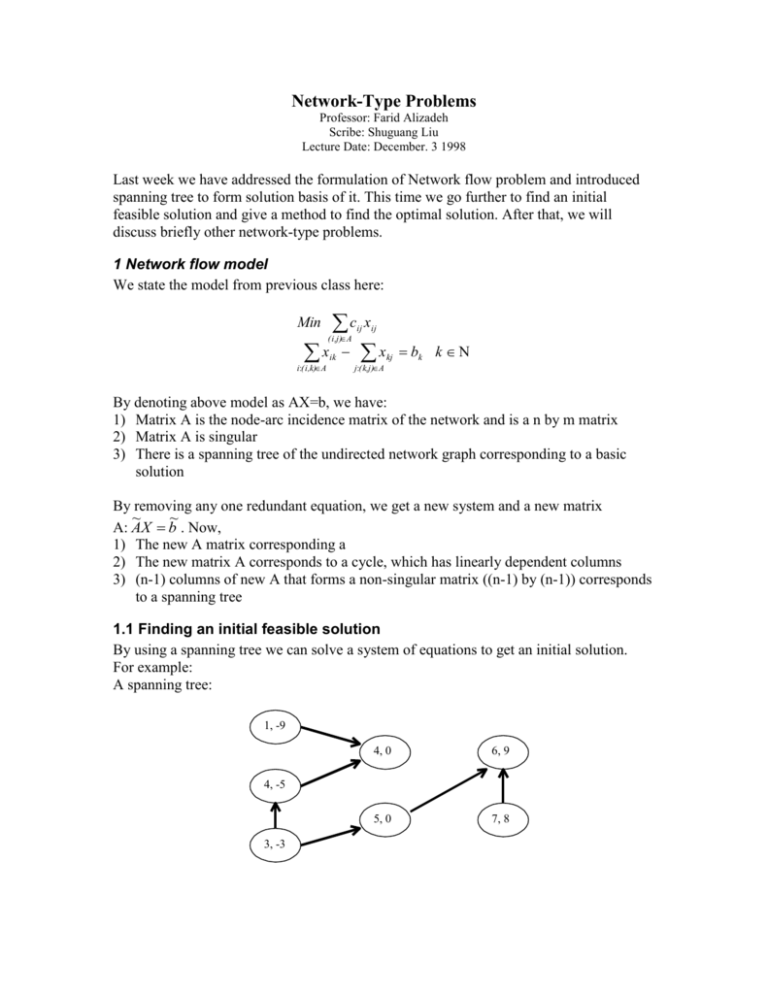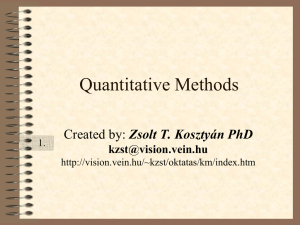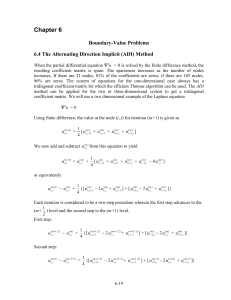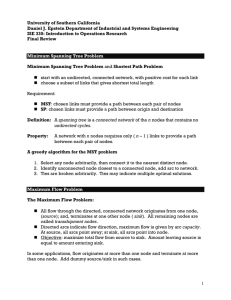Network-Type Problems
advertisement

Network-Type Problems Professor: Farid Alizadeh Scribe: Shuguang Liu Lecture Date: December. 3 1998 Last week we have addressed the formulation of Network flow problem and introduced spanning tree to form solution basis of it. This time we go further to find an initial feasible solution and give a method to find the optimal solution. After that, we will discuss briefly other network-type problems. 1 Network flow model We state the model from previous class here: Min c (i,j)Α x i:(i,k)Α ik ij xij x j:(k,j)Α kj bk k By denoting above model as AX=b, we have: 1) Matrix A is the node-arc incidence matrix of the network and is a n by m matrix 2) Matrix A is singular 3) There is a spanning tree of the undirected network graph corresponding to a basic solution By removing any one redundant equation, we get a new system and a new matrix ~ ~ A: AX b . Now, 1) The new A matrix corresponding a 2) The new matrix A corresponds to a cycle, which has linearly dependent columns 3) (n-1) columns of new A that forms a non-singular matrix ((n-1) by (n-1)) corresponds to a spanning tree 1.1 Finding an initial feasible solution By using a spanning tree we can solve a system of equations to get an initial solution. For example: A spanning tree: 1, -9 4, 0 6, 9 5, 0 7, 8 4, -5 3, -3 Notes: The first number of two numbers in an ellipse denotes the number of nodes; the second the demand of this nodes. The corresponding system of equations: x14 9 x14 x 24 0 x32 x 24 5 x35 x32 3 x35 x56 0 x56 x76 9 x76 8 The easy way to solve this system is to first find equation with only one variable; that is finding a leaf in the corresponding spanning tree. We get the solution. But it is not feasible, because it violates the nonnegative constraints. In fact, we need a procedure like phase 1 in the simplex method to get a feasible solution. This procedure can be described shortly as follows: Find a node receiving from all supplying nodes and sending to all other non-supply nodes. If we can not find a qualified node, we can pick up a node and construct arcs sending from all supplying nodes to this node or sending from this node to other non supply nodes. Then we solve the problem corresponding to this spanning tree. If this problem does not have zero objective value (cost), then the original problem is infeasible. If it does, we can obtain a feasible solution. 1.2 Using dual cost tree to find optimal solution Dual problem of minimum network flow problem: Max b k Ν k yk y j y i cij (i,j) Α As to above system, we know that primal problem has n-1 nonbasic v Suppose we have an initial primal flow solution: 1 7, 9 4 10, 9 6 10, 9 2 5, 5 12, 8 5 6, 8 7 3 Arcs on spanning tree Arcs on Non-spanning tree First number: cost; Second number: flow The dual cost solution: Set y1=0 1 3 y4=20 y6=27 7 4 10 6 10 2 y2=10 2 5 9 5 6 y5=21 3 3 12 7 y7=33 y3=15 Arcs on spanning tree Arcs on Non-spanning tree First number: cost; Second number: flow From dual cost solution, check the optimality of primal problem: We see that arc 14 does not satisfy optimality, so this arc should enter into the spanning tree, which corresponds to a nonbasic variable. Now by adding arc 14 in primal flow tree, we have a cycle. In this cycle we need to drop an arc to retain a spanning tree. Here we back to primal flow tree: 1 t 4 9-t 9-t 2 Arcs on spanning tree Arcs on Non-spanning tree First number: cost; Second number: flow From above, we set t=9. Then the whole primal flow tree: 1 -9 9 -5 9 4 0 6 2 5 8 8 5 7 3 -8 Arcs on spanning tree Arcs on Non-spanning tree First number: cost; Second number: flow Dual cost tree: Set y1=0 1 3 y4=3 y6=10 7 4 10 6 10 2 y2=10 5 6 3 2 9 3 12 5 y5=21 7 y7=33 y3=15 Arcs on spanning tree Arcs on Non-spanning tree First number: cost; Second number: flow Check for optimality. All the arcs, which are off the spanning tree, satisfy the inequalities. So, we find the optimal solution. 2. Shortest path problem In this section, we seek the shortest paths from a source to all other nodes in a network. h 18 a a h 9 c c 6 6 12 S s d 2 9 d g g f f 13 b b 12 6 e 10 e 17 A label-setting algorithm Label notes starting from the source node by (node, distance). Step 1: label source node: S S, 0 Step 2: separate labeled nodes from unlabeled nodes. And label node that has the shortest distance from separated labeled notes set. A, 6 a b b 6 S S, 0 9 Keep doing step2 until all nodes have been labeled. Step 3: s, 6 18 a 6 S S, 0 2 9 a, 8 b c c Step 4: S, 6 18 a c c b,20 e 6 S s 2 9 a, 8 b 12 Step 5: S,6 18 a a,24 c 6 S S,0 d 2 9 a,8 d g g f f h h e,26 g f f 13 b 12 6 b,20 10 e 17 Step 6: S,6 18 a a,24 6 9 c 6 S S,0 d 2 9 a,8 d 13 b 12 6 b,20 e 17 Step 7: h S,6 18 a a,24 6 h 9 c 6 12 S S,0 c,30 2 9 a,8 d e,26 g f f c,33 h 13 b 12 6 b,20 e 17 Step 8: S,6 18 a a,24 6 9 c 6 12 S S,0 c,30 2 9 a,8 d e,26 g f f c,33 h 13 b 12 6 b,20 10 e 17 Step 9: S,6 18 a a,24 6 9 c 6 12 S S,0 c,30 2 9 a,8 e,26 g e,37 f 13 b 12 6 b,20 10 e 17 Finally, we get the solution. (s, a)=6 (s, b)=8 (s, c)=24 d (s, d)=30 (s, e)=20 (s, f)=37 (s, g)=26 (s, h)=33 3 Maximum flow problem Maximum flow problem is an another special type of network flow problem. This problem can be stated as follows: Suppose we have a network, which has one supplying node and one demanding node, and the others are intermediate nodes. The objective is to push as much flow from the supplying node to demanding node as possible. And the capacities of the arcs connecting these nodes are not infinite (they are upper bounded). c,24 b,6 S c,30 t a,8 d,20 Cts=-1 We can construct this problem by introducing a dummy arc from demanding node t to supplying node s, and assuming cts negative (here it is set to -1). At the same time, we let all cij=0 (the cost of transporting through arc ij), and let all the demands of all nodes to be zero (bI=0). Now since the only nonzero cost of the network is negative, we can transfer as much flow as possible from demanding node t to supplying node s, in order to get maximum profit. Now the model is as follows: Max - xts xit xtj 0 i:(i,k) Α j:(k,j) Α 0 xij u ij









